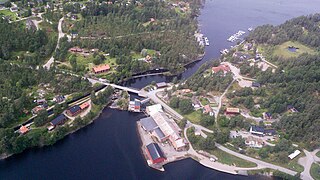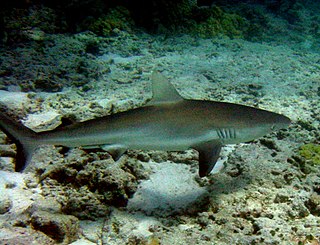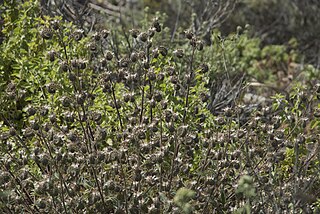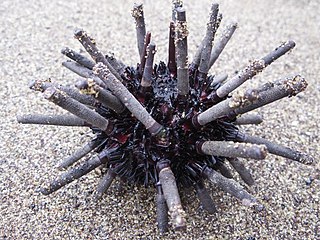
Årjäng Municipality is a municipality in Värmland County in west central Sweden, bordering Norway. Its seat is located in the town of Årjäng.

The white-cheeked pintail, also known as the Bahama pintail or summer duck, is a species of dabbling duck. It was first described by Carl Linnaeus in his landmark 1758 10th edition of Systema Naturae under its current scientific name.

Jasminocereus is a genus of cacti with only one species, Jasminocereus thouarsii, endemic to the Galápagos Islands, territorially a part of Ecuador. In English it is often called the candelabra cactus. At maturity it has a branched, treelike habit, and may be up to 7 m (23 ft) tall. The stems are made up of individual sections with constrictions between them. Its creamy white to greenish flowers open at night and are followed by greenish to reddish fruits.

The brown noddy or common noddy is a seabird in the family Laridae. The largest of the noddies, it can be told from the closely related black noddy by its larger size and plumage, which is dark brown rather than black. The brown noddy is a tropical seabird with a worldwide distribution, ranging from Hawaii to the Tuamotu Archipelago and Australia in the Pacific Ocean, from the Red Sea to the Seychelles and Australia in the Indian Ocean and in the Caribbean to Tristan da Cunha in the Atlantic Ocean. The brown noddy is colonial, usually nesting on elevated situations on cliffs or in short trees or shrubs. It only occasionally nests on the ground. A single egg is laid by the female of a pair each breeding season. In India, the brown noddy is protected in the PM Sayeed Marine Birds Conservation Reserve.

The Galapagos shark is a species of requiem shark, in the family Carcharhinidae, found worldwide. It favors clear reef environments around oceanic islands, where it is often the most abundant shark species. A large species that often reaches 3.0 m (9.8 ft), the Galapagos reef shark has a typical fusiform "reef shark" shape and is very difficult to distinguish from the dusky shark and the grey reef shark. An identifying character of this species is its tall first dorsal fin, which has a slightly rounded tip and originates over the rear tips of the pectoral fins.

Mugil is a genus of mullet in the family Mugilidae found worldwide in tropical and temperate coastal marine waters, but also entering estuaries and rivers.

Phacelia egena is a species of phacelia known by the common name Kaweah River phacelia. It is native to much of California, from the Transverse Ranges to the northern mountains and into Oregon; it also occurs in Arizona. It grows in many types of habitat.
Cyclotorna egena is a moth of the family Cyclotornidae. It is found in Australia, including New South Wales and Queensland.
Notioplusia illustrata, the notioplusia moth, is a moth of the family Noctuidae first described by Achille Guenée in 1852. It is native to Saint Kitts, the Greater Antilles, Florida, Mexico, Panama and South America. It was introduced to Australia and South Africa.

Starksia galapagensis, the Galapagos blenny, is a species of labrisomid blenny endemic to the Galapagos Islands. It inhabits rocky reefs with plentiful weed-growth at depths of from 3 to 25 m. This species can reach a length of 4.5 cm (1.8 in) TL.
Turbonilla galapagensis is a species of sea snail, a marine gastropod mollusk in the family Pyramidellidae, the pyrams and their allies.
Eupithecia egena is a moth in the family Geometridae. It is found in China.
Clarkeulia egena is a species of moth of the family Tortricidae. It is found in Paraná, Brazil.
Neodactylota egena is a moth of the family Gelechiidae. It was described by Ronald W. Hodges in 1966. It is found in North America, where it has been recorded from California and Arizona.
Campodea egena is a species of two-pronged bristletail in the family Campodeidae.

Eucidaris galapagensis, commonly referred to as the slate pencil sea urchin, is a species of echinoderms in the family of Cidaroid. This sea urchin lives in coastal areas in the Galapagos, Clipperton, and Cocos. The preferred substrate of these organisms is rocky, benthic environments that provide refuge. In fact, greater abundance of Slate Pencil Sea Urchins is correlated with correct substrate, as well as greater food availability. Their diet is primarily herbivorous, however, they also consume various invertebrates. They graze heavily on live corals and algae in open, shallow reef habitats. Their grazing schedule is not restricted to sunlight availability, and will graze nocturnally. Their diversity in diet is a result of their metabolism, as they are capable of remarkably efficient assimilation of nutrients. Pencil Slate Sea Urchin's crawl omnidirectionally in their environment. Additionally, they are able to sense surrounding light by photoreceptor cells that act as their visual system.

Peperomia galapagensis is a species of flowering plant in the Piperaceae (pepper) family. It is endemic to the Galapagos Islands.

Nolana galapagensis, is a species of flowering plant in the Solanaceae (nightshade) family. It is endemic to the Galapagos Islands.
This page is based on this
Wikipedia article Text is available under the
CC BY-SA 4.0 license; additional terms may apply.
Images, videos and audio are available under their respective licenses.












